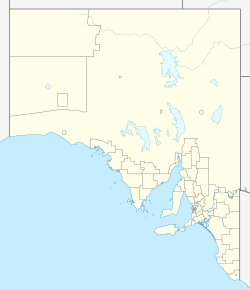Busby Islet facts for kids
| Geography | |
|---|---|
| Location | Nepean Bay |
| Coordinates | 35°37′27″S 137°38′26″E / 35.62416°S 137.6405°E |
| Area | 10 ha (25 acres) |
| Highest elevation | 1 m (3 ft) |
| Administration | |
|
Australia
|
|
| Demographics | |
| Population | 0 |
Busby Islet is a small island in South Australia. It's also known as Bushy Island or Anchorage Island. You can find it in Nepean Bay, which is on the north coast of Kangaroo Island. It's about 2 kilometers (1.2 miles) north of Kingscote, a town on Kangaroo Island. This islet and the areas around it are very important because they are home to many different kinds of birds. Busby Islet has been a protected area since 1909, meaning it's a special place kept safe for nature. Since at least 1972, it has been part of the Busby Islet Conservation Park.
Contents
What is Busby Islet?
Busby Islet is a small island located in Nepean Bay. It's about 2 kilometers (1.2 miles) east of Kingscote on Kangaroo Island. Busby Islet, along with the Beatrice Islets, are like high spots on the southern edge of a long, narrow strip of land called a spit. This spit, known as 'The Spit', becomes visible when the tide is low.
The Spit stretches from Cape Rouge, about 5 kilometers (3.1 miles) north of Kingscote. It goes southeast across the entrance of the Bay of Shoals for about 5 nautical miles (9.3 kilometers). Busby Islet itself covers an area of about 10 hectares (25 acres). In 1996, its highest point was about 1 meter (3.3 feet) above sea level.
How Was It Formed?
The Spit, and with it Busby Islet and the Beatrice Islets, started to form about 7,500 years ago. This happened when sea levels reached their current height. The islet is made of sand and sandgrit, which have created small, low sand dunes at its top. At low tide, the islet is part of a drying spit. Just south of it, the water quickly drops to a depth of about 5 meters (16 feet) within 0.25 kilometers (0.16 miles).
Plants and Animals
Busby Islet is a home for various plants and animals, especially birds.
Plants on the Islet
In 1996, reports showed that Busby Islet had many plants that can handle a lot of salt. These included 'low shrubland' plants like grey samphire, glassworts, and Austral seablite. The very top of the island had plants that are a bit less tolerant to salt, such as nitre bush and African boxthorn.
Animals on the Islet
Birds are the main animals found on Busby Islet. Surveys in 1980 and 1981 recorded many different bird species. Some of these include:
- Australian pelican
- Black-faced shag
- Little pied cormorant
- Little black cormorant
- Pied cormorant
- White-faced heron
- Sacred ibis
- Chestnut teal
- Black swan
- Brown falcon
- Grey plover
- Pied oystercatcher
- Sooty oystercatcher
- Ruddy turnstone
- Silver gull
- Pacific gull
- Caspian tern
- Fairy tern
- Crested tern
- Sharp-tailed sandpiper
- Red-necked stint
- Curlew sandpiper
- Eastern curlew
- Whimbrel
- Greenshank
- Rock parrot
- Raven
- Little grassbird
Little Penguins
In the past, little penguins used to live in burrows near Busby Islet and its sandy areas. However, these penguins were not seen during the surveys in 1980 and 1981. Sadly, by 2011, it was believed that this group of penguins had disappeared from the area.
History of Busby Islet
European Discovery
The famous explorer Matthew Flinders is said to have originally named the islet Bushy Island. However, it seems a spelling mistake might have happened, leading to Busby Island becoming the official name by 1869. The name Anchorage Island has also been used for this islet. Interestingly, the name Bushy Island is still used on British Admiralty charts and in some American documents.
Before 1919, people used to mine guano (which is bird droppings used as fertilizer) from Busby Islet. They did this under a special license from the South Australian Government.
Why is it Protected?
Busby Islet first became a protected area on May 13, 1909. This was done under a law called the Birds Protection Act 1900. Later, it was officially declared a fauna reserve (a place for animals) under the Fauna Conservation Act 1964. In 1967, it was again set aside to protect wildlife habitats. Finally, in 1972, it became a conservation park under the National Parks and Wildlife Act 1972.
Since 2012, the waters around the islet have been part of a special "sanctuary zone" within the Encounter Marine Park. This means that, as of October 2014, Busby Islet itself is a 'no entry' area. This rule helps to protect the delicate environment and the animals that live there.
Busby Islet is also part of a larger area that includes The Spit within Nepean Bay and the Beatrice Islets. This whole area is listed as an important wetland in South Australia in A Directory of Important Wetlands in Australia.


